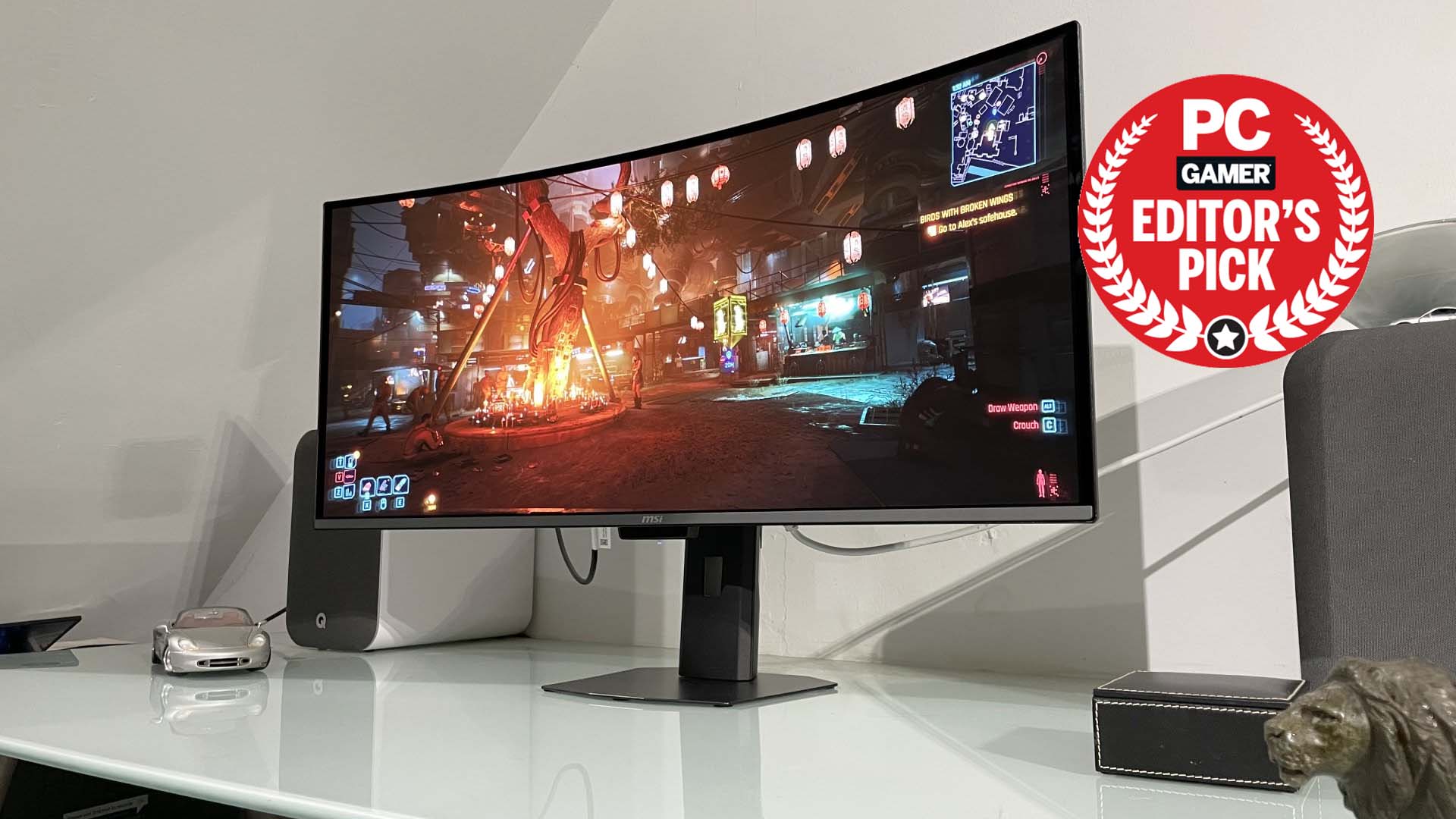Our Verdict
The ROG Falcata might look like an ergonomic gaming keyboard, but it's not marketed as such, nor is it comfortable enough to be one. Purely for gaming, it's a superb keyboard, but concerns over build quality, the use of proprietary cables, and a high price tag mean you're better off looking elsewhere for a high-spec boutique keyboard.
For
- Super-fast switches
- Plush, cushioned typing
- Top-tier gaming features
Against
- High price tag
- Looks ergonomic but it's not very ergo
- Proprietary link cable
- Iffy media wheel
PC Gamer's got your back
Here's a simple conundrum for you. When is an ergonomic keyboard not an ergonomic keyboard? There's probably a host of different answers that could be said in response, but for me, it's when the keyboard is an Asus ROG Falcata.
It looks like an ergonomic keyboard, and it even has many of the usual features of boutique ergonomic keyboards, yet Asus doesn't market the ROG Falcata as one. In fact, the product page doesn't contain the word 'ergonomic' anywhere, other than in a review quote. Essentially, it's a full-on gaming keyboard that just so happens to be fully split, with optional tenting and tilting.
So why go to all that bother if it's not about ergonomics? Well, Asus says, "the unique split design allows users to detach the side of the right keyboard, retaining the left half when gaming…free[ing] up even more space for mouse movement."
With that in mind, let's focus on the gaming keyboard aspects of the ROG Falcata, though I will talk about its ergonomics later in this review. Fundamentally, what you've got is a compact mechanical keyboard, with ROG HFX V2 magnetic switches (aka Hall effect), 8 kHz polling, RGB per-key backlighting, and a multi-function media wheel. Oh, and a $420 (£335) price tag.

Size: 75% fully-split
Switches: ROG HFX V2 Magnetic Switch
Backlighting: Per key RGB
Anti-ghosting: N-key rollover
Polling rate: up to 8,000 Hz (USB/2.4G)
Dimensions: 327 x 127 x 38 mm (without wrist rests)
Weight: 968 g / 2.13 lbs (without cable and wrist rests)
Connections: 2.4 GHz | USB Type-C | Bluetooth 5
Price: £334 | $420
It's not the most expensive gaming keyboard Asus makes (I believe the ROG Azoth Extreme currently takes the honour, at £480), but it's a high enough price to make one very picky about what's being offered here. Because if you're going to hand over that kind of money for a keyboard, you need to know if it's going to be perfect for you.
I'm going to jump the gun a bit here and say this now: The ROG Falcata has a handful of really awful aspects to it, but if you can ignore them, the keyboard itself is fantastic.
Let's start with the positives. The switches are pure gaming nirvana, being extremely fast and responsive. In fact, until using the Falcata, I hadn't realised just how much I rest my fingers on keys during gaming. The default sensitivity of the HFX V2 switches is so fine that they trigger on the slightest of pressures. That aspect of them is very easy to adjust, but I left them as standard, and instead controlled my own gaming style.
Keep up to date with the most important stories and the best deals, as picked by the PC Gamer team.
Thanks to two silicone layers and two Poron pads, every press is wonderfully cushioned. There's not a hint of key rattle or squeak to be found, just a gentle 'clack' at the end of the key travel. Given its gaming credentials, you naturally have a rapid trigger and Speed Tap (aka snap tap) functionality, with the former being controlled via a toggle switch on the rear.
Rapid trigger is normally just assigned to the WASD keys, though you can customise this to other switches via Asus' browser-based Gear Link control software. Speed Tap isn't enabled by default, as it will override the behaviour of multiple key presses, but it too is easy to activate, either via the keyboard itself or through Gear Link. The standard setting for Speed Tap is to only apply it to the A and D keys, but you can configure other pairs as required.
Something else that's pretty good, for a gaming keyboard, is the overall ergonomics. Yes, I know it's not an true ergonomic keyboard—it's actually not exactly a great ergo keyboard, for reasons that I will explain shortly—but the split chassis is great for getting your shoulders into a comfortable position for long gaming sessions, and you can attach large silicone pads that screw to each half of the keyboard.
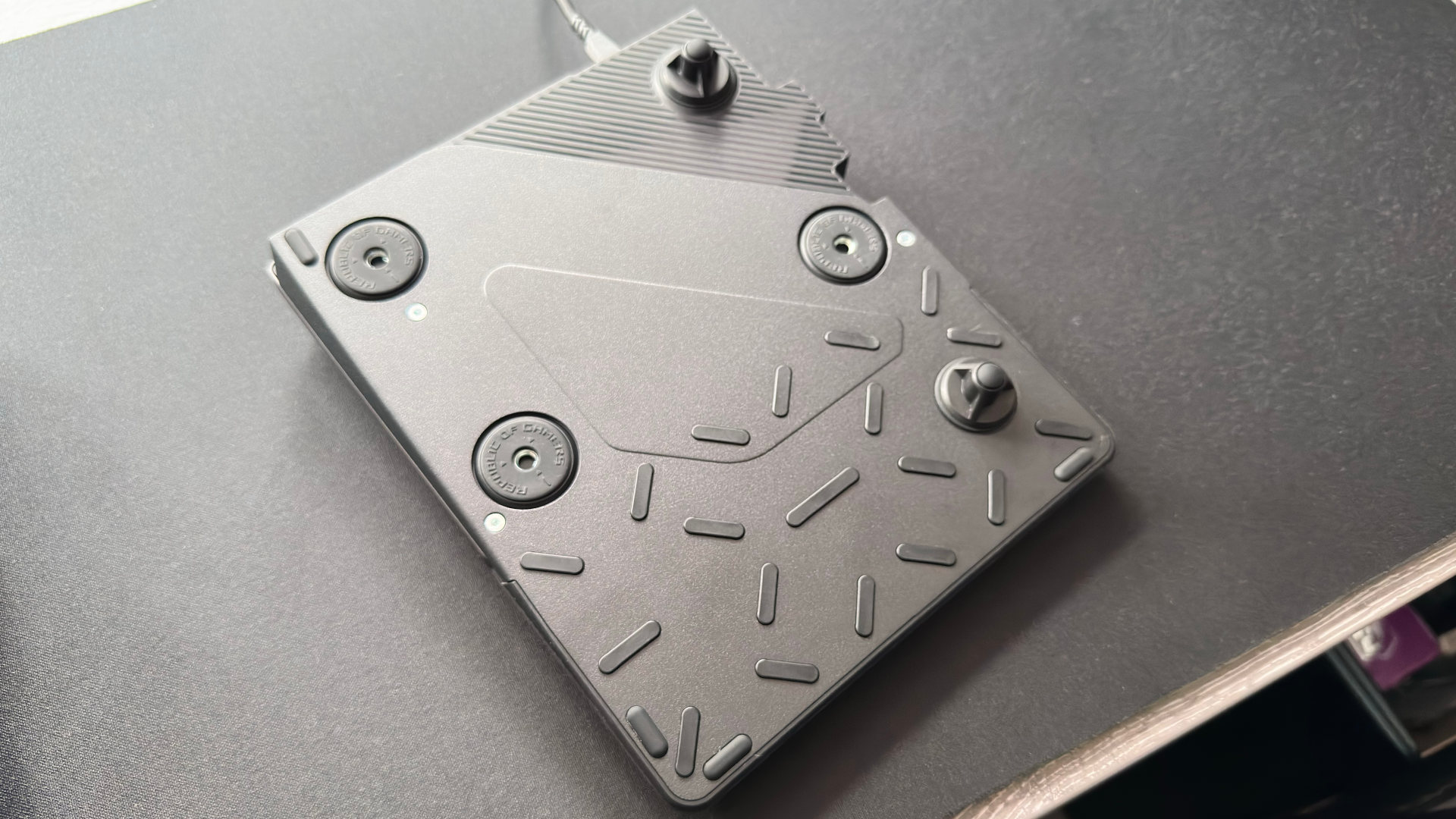
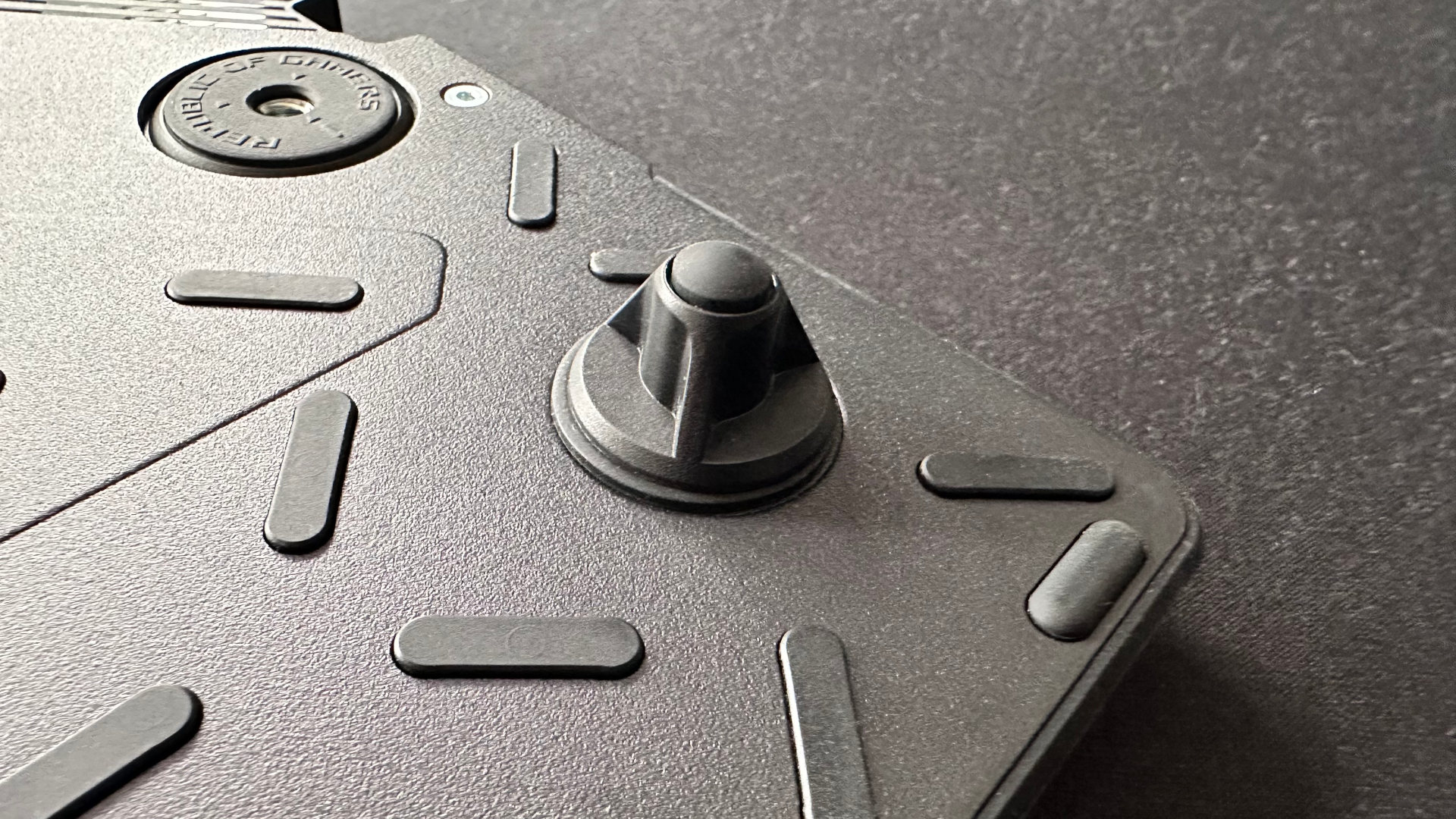
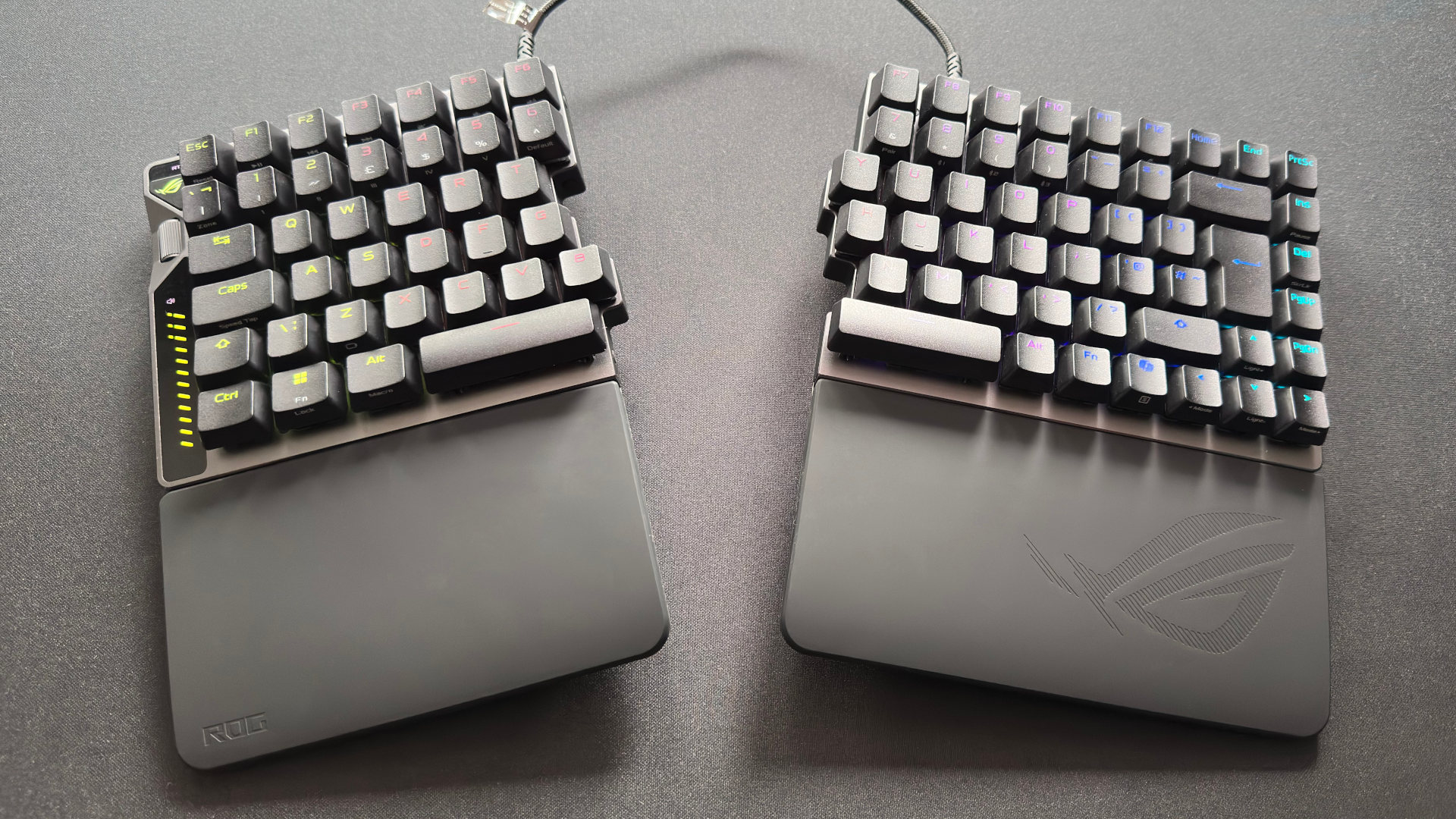
You can then screw small plastic feet (of two different sizes) into various holes in the bases to tilt or tent the ROG Falcata. Note that you can really only do one or the other, and it's a bit of a shame that you can't place the feet in the right positions to achieve both. I found the ROG Falcata to be at its most comfortable with the larger feet inserted to give the keyboard roughly 10 degrees of tenting. Compared to most gaming keyboards I've used, though, it's really quite luxurious.
The silicone pads are somewhat fiddly to attach, though they're worth using, as the material is dense, yet compliant. They feel very nice, much better than most wristpads, but they're not tall enough for my liking. The Falcata's keys are high-profile, and after a few hours of typing, my wrists tend to ache a little because they're being bent slightly to allow my fingers to ride over the keys.
Compared to the Kinesis Gaming Freestyle Edge, which also has high-profile keys and high-profile wristpads, the insufficient wrist support is probably one reason why Asus chose not to market the ROG Falcata as an ergonomic keyboard. It's a real shame because with better wristpads, this keyboard might be good enough to knock the Freestyle Edge off its throne as the best ergo gaming keyboard.
Well, perhaps not. There's not enough freedom of choice in the tenting and tilting options to make Kinesis worry about its design, and beyond its ergonomic aspects, there's one bit of the ROG Falcata that made me dislike it a great deal for the first week of using it.
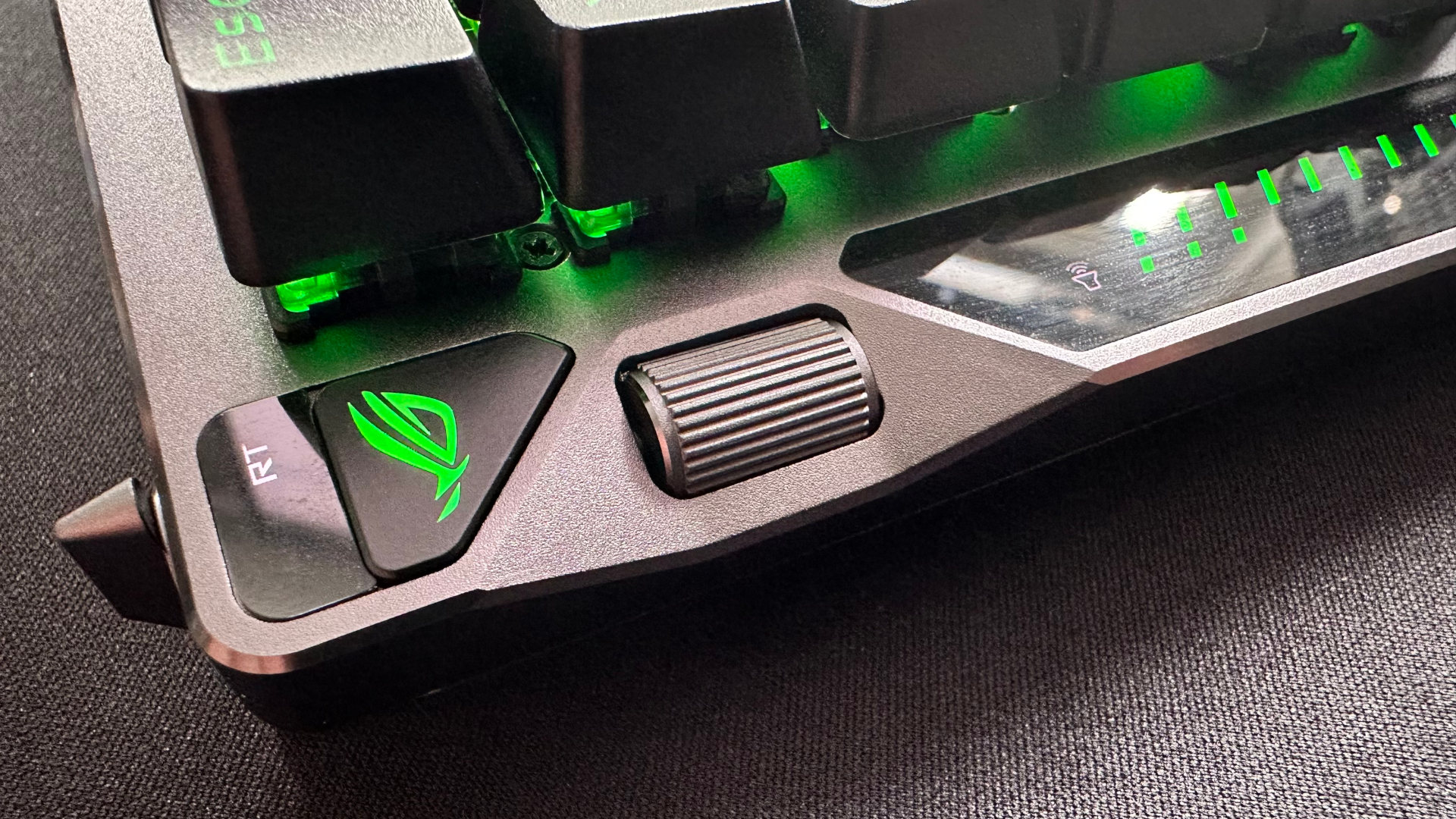

It's the multifunction media wheel. On paper, it should be brilliant: a button just above it cycles through volume controls, the sensitivity of the rapid trigger, keyboard actuation points, media playback, lighting, and even custom commands. Below the wheel, there's a large dynamic LED strip that lets you know what level you've set everything to at a glance.
Unfortunately, the wheel itself is so stiff to rotate that it's practically impossible to use as intended. I suspect this is a manufacturing defect in my review sample, as I've seen other reviews of this keyboard in which the tester was able to flick it around easily. But if I've run into trouble with it, there's a good chance you might too.
Even if it did scroll easily, it's a little too small and gets overshadowed by nearby keys. Given what the wheel is capable of controlling, I'm surprised that Asus settled on such an understated design. I mean, the toggle switch for rapid trigger is almost just as large.
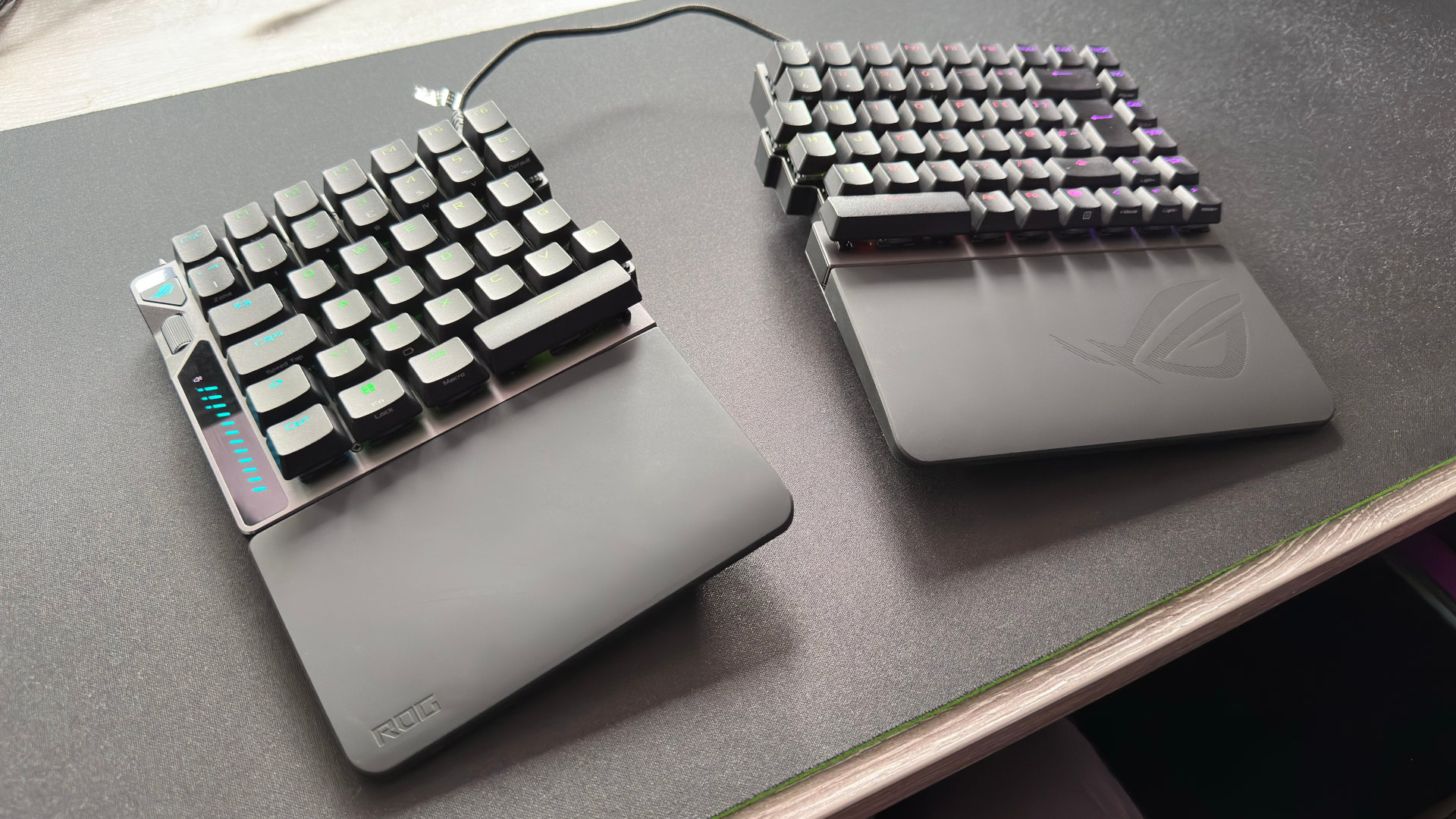
While I'm in a complaints mode, let's talk about the connectivity options. You've got USB Type-C, Bluetooth, or a 2.4 GHz dongle with 8,000 polling. Asus claims that when used wirelessly, you can get up to 200 hours of battery life, with the RGB lighting disabled. So what am I complaining about?
My main gripe is the fact that the two keyboard halves have to be connected via a proprietary cable. The Kinesis Freestyle Edge is the same, but it's not $400+ (£334), and I've tested plenty of ergonomic split keyboards that happily communicate entirely wirelessly.
Worse still is that said cable looks like a standard USB Type-C, but its internal wiring is completely different. "Using third-party cables may result in the keyboard not responding," says Asus, and having tested multiple USB cables myself, I can tell you now that there's no 'may' about it.
You get two versions of the required cable in the box, but one of them is so short that it's only usable for when you have the two keyboard halves right next to each other, defeating the whole point of having a split keyboard. At this price point, the ROG Falcata should be fully wireless, though I suppose this allows Asus to design a V2 in the future that addresses this niggle.
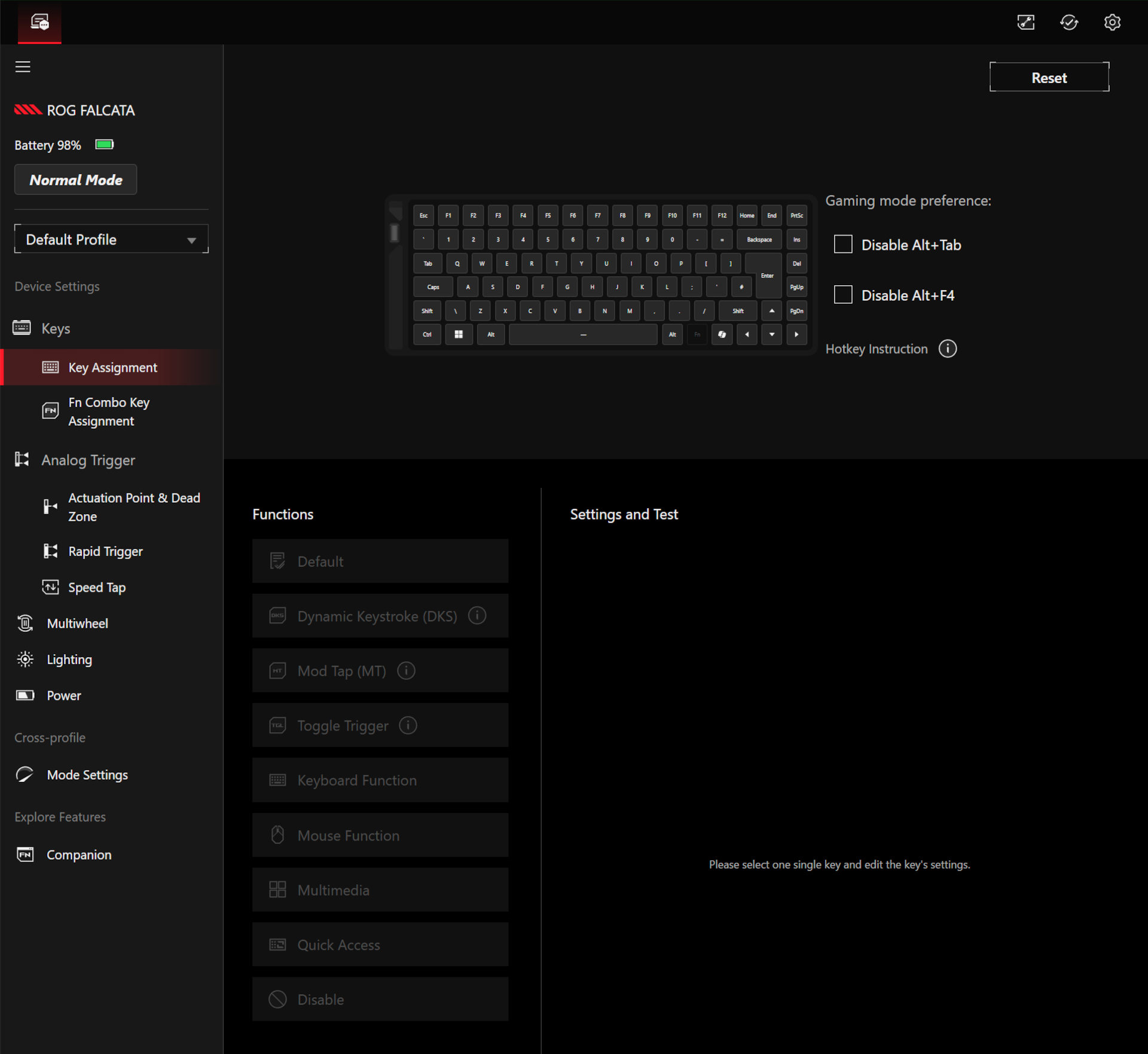
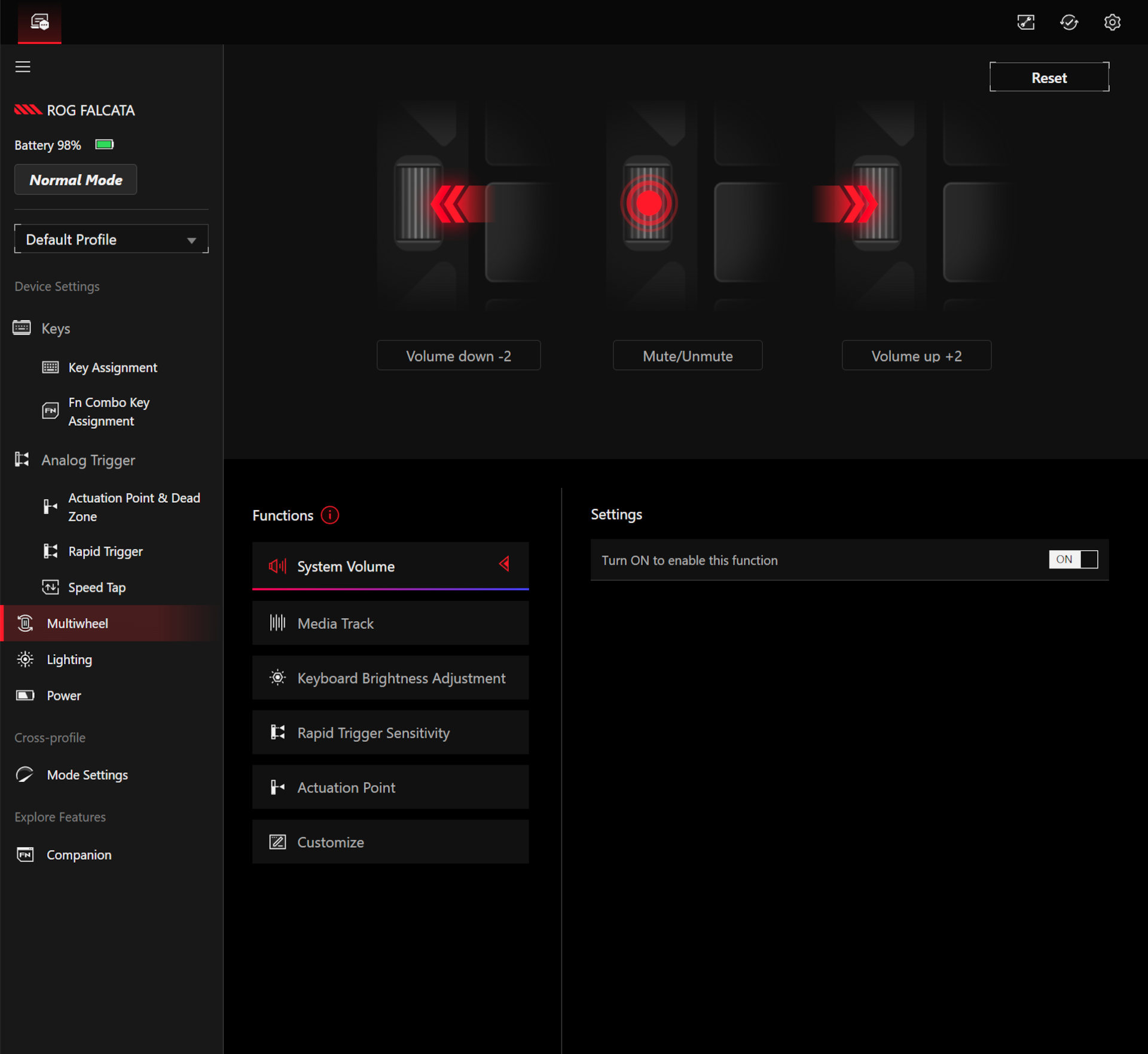
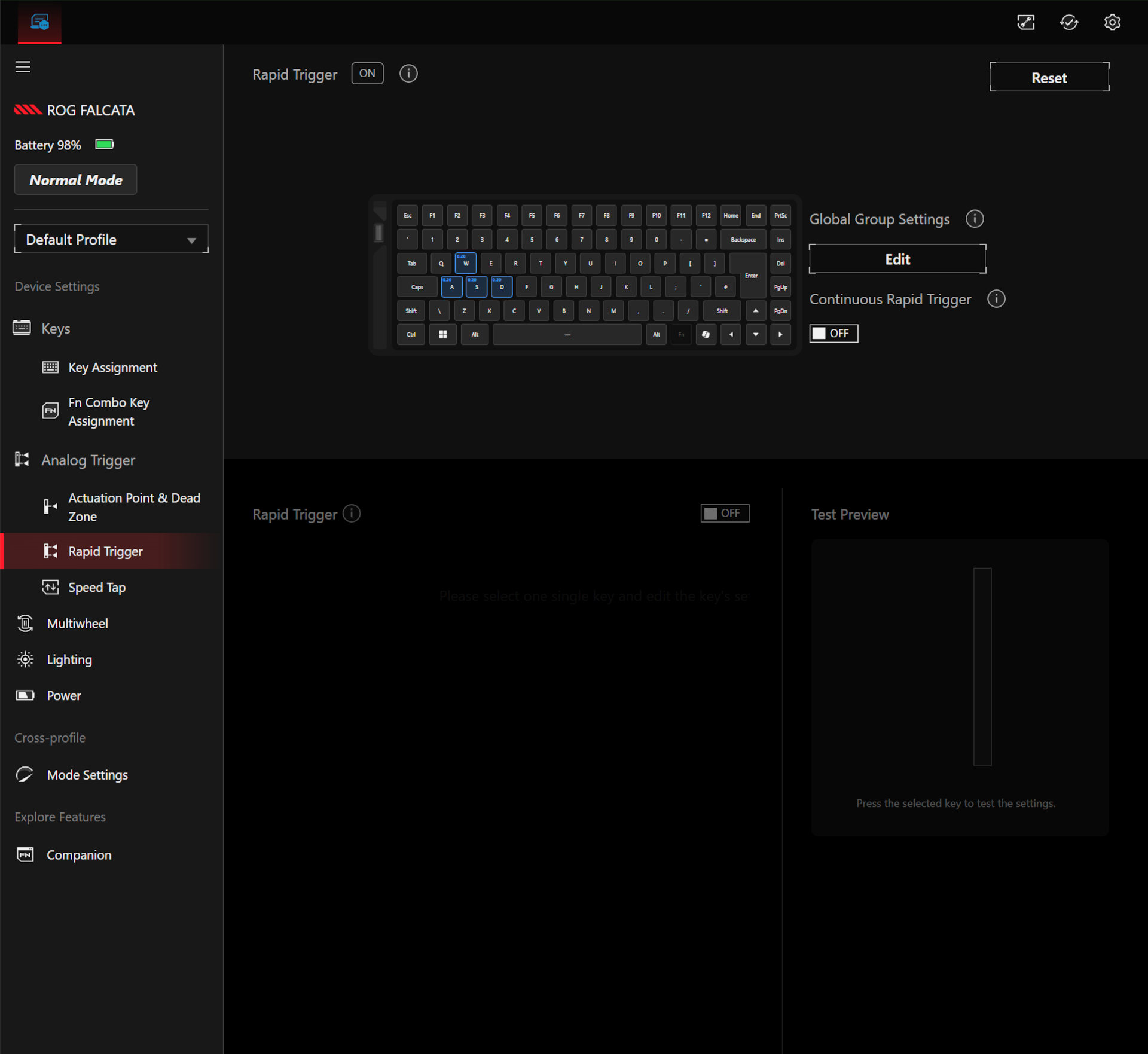
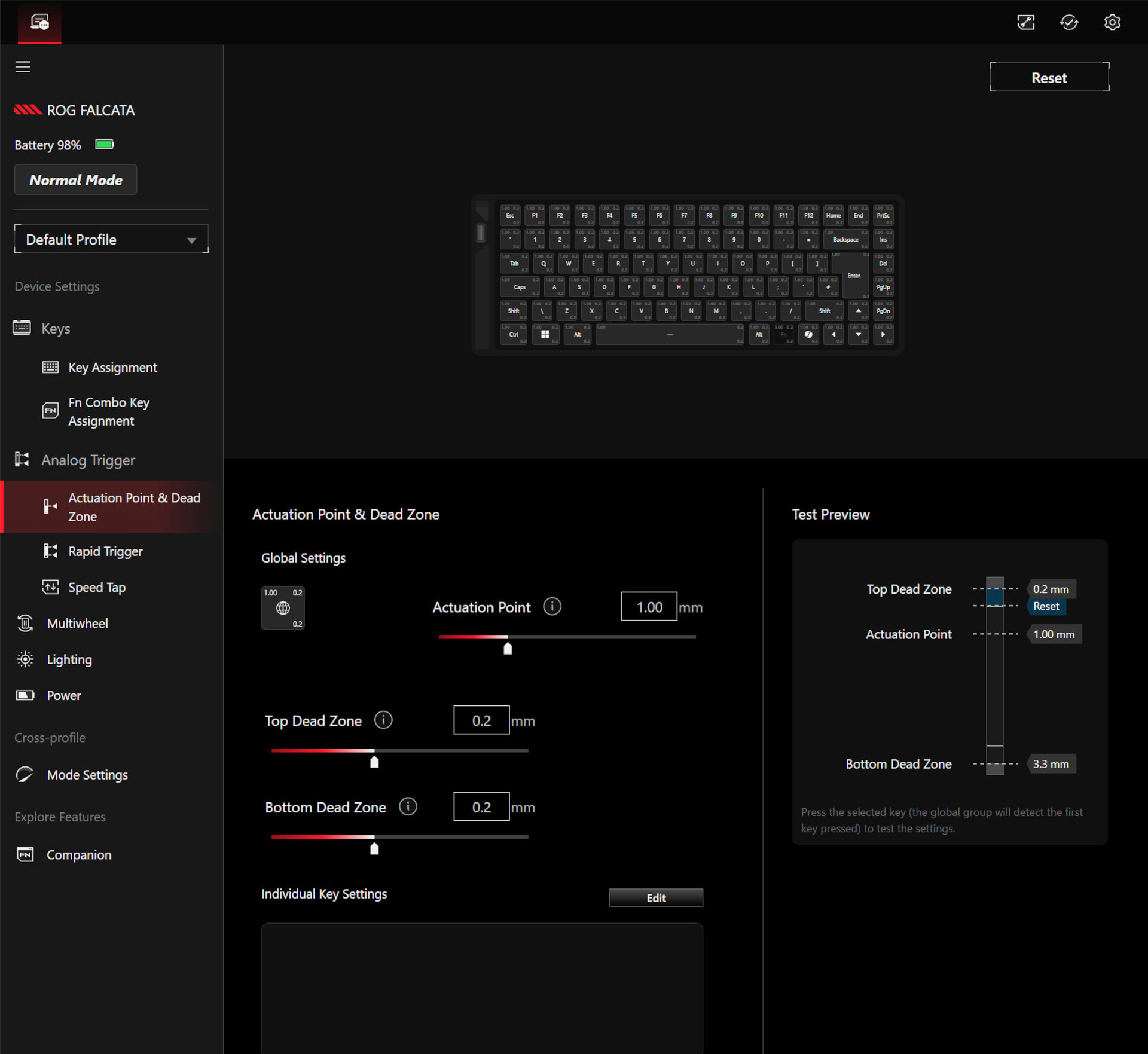
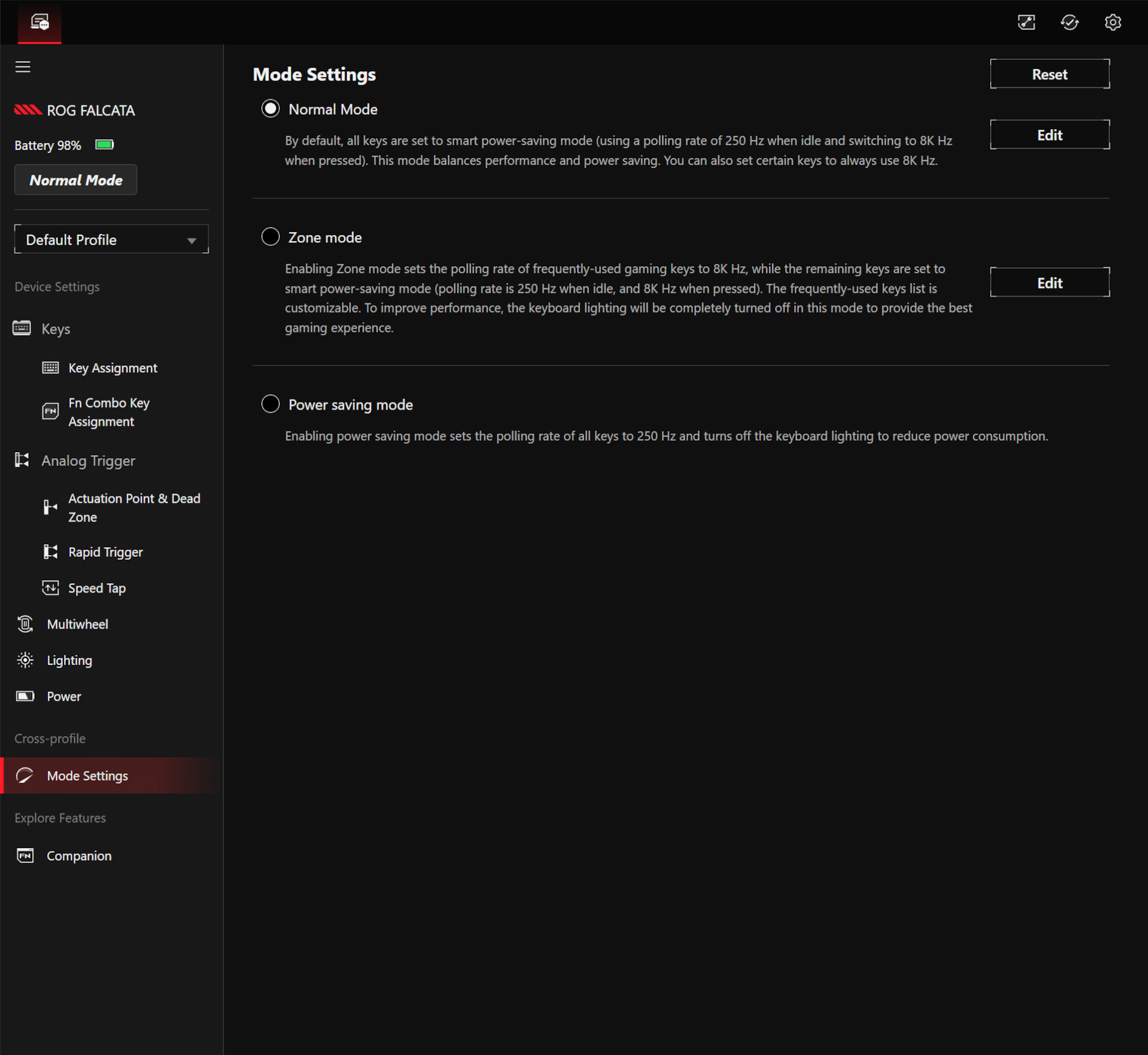
My last grumble pertains to Gear Link. I'm happy that Asus has moved away from using a native clunky app to something online, which lets it easily fix bugs and add new features without forcing users to download anything. It's rich in features and easy to use, but there's no option to set up macros, as such. That's hardly a deal breaker, as the keyboard itself doesn't have any keys free for alternate usage (other than the Copilot key, I guess), but I'd certainly like to have the option.
Admittedly, Gear Link is still in beta, and there are a few other issues with it, such as some functions either not working as they should or not working entirely. You could argue that it's not ready for full-time use, and while that's common in the world of small-scale boutique keyboard companies, it's certainly not something you'd expect from the size of Asus. I suppose I should be thankful that you don't have to use its incredibly cumbersome Armoury Crate app with this keyboard.
✅ You want a unique-looking keyboard with all the top gaming features. Rapid trigger, snap tap, and adjustable Hall effect switches are the best features of the ROG Falcata.
❌ You want to spend $300 or more on an ergonomic gaming keyboard. The ROG Falcata might look like it's supremely comfortable with its split layout, but the low wrist pads and high keys will give your wrists grief after a few hours.
Overall, the Asus ROG Falcata has a lot going for it. For pure gaming, it's absolutely superb, faster and more responsive than anything else I have ever used. Due to the low wrist pads and high keys, it's too uncomfortable for all-day, all-night use, which is a shame as the ergonomics have the potential to be excellent.
If we assume the media wheel stiffness to be a one-off, then the rest of the build quality helps in no small way to justify the very high cost. The same is true of the full feature set and typing experience; it's genuinely a lovely keyboard.
The problem is that at £334, you've got a vast array of options to choose from—pure gaming, split ergonomic, or otherwise—and unfortunately, it's not quite good enough to get away with that price tag.
At the moment, we have only found one US price for the Asus ROG Falcata, and it's over $400. Would you be willing to spend that kind of money only to find that your sample also has an unusable media wheel or that it's just too uncomfortable to use for many hours?
I know I wouldn't, and that's a great pity, because the ROG Falcata could have easily been one of the best gaming keyboards I've ever used.
The ROG Falcata might look like an ergonomic gaming keyboard, but it's not marketed as such, nor is it comfortable enough to be one. Purely for gaming, it's a superb keyboard, but concerns over build quality, the use of proprietary cables, and a high price tag mean you're better off looking elsewhere for a high-spec boutique keyboard.

Nick, gaming, and computers all first met in the early 1980s. After leaving university, he became a physics and IT teacher and started writing about tech in the late 1990s. That resulted in him working with MadOnion to write the help files for 3DMark and PCMark. After a short stint working at Beyond3D.com, Nick joined Futuremark (MadOnion rebranded) full-time, as editor-in-chief for its PC gaming section, YouGamers. After the site shutdown, he became an engineering and computing lecturer for many years, but missed the writing bug. Cue four years at TechSpot.com covering everything and anything to do with tech and PCs. He freely admits to being far too obsessed with GPUs and open-world grindy RPGs, but who isn't these days?
You must confirm your public display name before commenting
Please logout and then login again, you will then be prompted to enter your display name.

